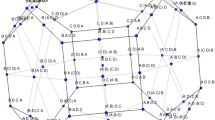Abstract
In this paper, we deal with ranking problems arising from various data mining applications where the major task is to train a rank-prediction model to assign every instance a rank. We first discuss the merits and potential disadvantages of two existing popular approaches for ranking problems: the ‘Max-Wins’ voting process based on multi-class support vector machines (SVMs) and the model based on multi-criteria decision making. We then propose a confidence voting process for ranking problems based on SVMs, which can be viewed as a combination of the SVM approach and the multi-criteria decision making model. Promising numerical experiments based on the new model are reported.
Similar content being viewed by others
References
Alexe, S., Hammer, P. L., Kogan, A., & Lejeune, M. A. (2003). A nonrecursive regression model for country risk rating (Technical Report). Rutgers University, Center for Operations Research, Piscataway, New Jersey.
Bottou, L., Cortes, C., Denker, J. S., Drucker, H., Guyon, I., Jackel, L. D., LeCun, Y., Müller, U. A., Säckinger, E., Simard, P., & Vapnik, V. (1994). Comparison of classifier methods: a case study in handwritten digit recognition. In ICPR (pp. 77–87).
Burges, C. (1998). A tutorial on support vector machines for pattern recognition. Data Mining and Knowledge Discovery, 2, 121–167.
Cardoso, J. S., Pinto da Costa, J. F., & Cardoso, M. J. (2005). Modelling ordinal relations with SVMs: An application to objective aesthetic evaluation of breast cancer conservative treatment. Neural Networks, 18(5–6), 808–817.
Chang, C., & Lin, C. (2004). User manual for LIBSVM, http://www.csie.ntu.edu.tw/~cjlin/libsvm.
Cortes, C., & Vapnik, V. (1995). Support-vector networks. Machine Learning, 20, 273–297.
Crammer, K., & Singer, Y. (2001). Pranking with ranking. In Proceedings of the conference on neural information processing systems (NIPS2001).
Doumpos, M., & Zopounidis, C. (2002). Multicriteria decision aid classification methods. Applied optimization (Vol. 73). Norwell: Kluwer Academic.
Doumpos, M., Zanakis, S. H., & Zopounidis, C. (2001). Multicriteria preference disaggregation for classification problems with an application to global investing risk. Decision Sciences, 32, 333–385.
Herbrich, R., Graepel, T., & Obermayer, K. (1999). Support vector learning for ordinal regression, In 9th international conference on artificial neural networks (ICANN 99) (pp. 97–102).
Herbrich, R., Graepel, T., & Obermayer, K. (2000). Large margin rank boundaries for ordinal regression. In A. Smola, P. Bartlett, B. Schölkopf, & D. Schuurmans (Eds.) Advances in large margin classifiers (pp. 115–132). Cambridge: MIT Press.
Hsu, C., & Lin, C. (2002). A comparison of methods for multi-class support vector machines. IEEE Transactions on Neural Networks, 13, 415–425.
Kressel, U. (1999). Pairwise classification and support vector machines. In B. Scholkopf & C. J. C. Burges (Eds.) Advances in kernel methods: support vector learning (pp. 255–268). Cambridge: MIT Press.
Moguerza, J. M., & Mun̈oz, A. (2006). Support vector machines with applications. Statistical Science, 21(3), 322–336.
Newman, D. J., Hettich, S., Blake, C. L., & Merz, C. J. (1998). UCI Repository of Machine Learning Databases, Irvine, CA, University of California, Department of Information and Computer Science. See also http://www.ics.uci.edu/~mlearn/MLRepository.html.
Peng, J. M., & Wang, X. J. (2005). Generalized utility additive discrimination and its application to country risk classification (Technical report). Department of CAS, McMaster University, Hamilton, Ontario, Canada.
Platt, J. C., Cristianini, N., & Shawe-Taylor, J. (2000). Large margin DAGs for multiclass classification. In Advances in neural information processing systems (Vol. 12, pp. 547–553). Cambridge: MIT Press.
Smola, A. J., & Schölkopf, B. (2004). A tutorial on support vector regression. Statistics and Computing, 14, 199–222.
Vapnik, V. (1998). Statistical learning theory. New York: Wiley.
The World Bank (2002). World Development Indicators on CD-ROM, IBRD World Bank, Washington, D.C.
Zopounidis, C., & Doumpos, M. (2002). Multi-criteria decision aid in financial decision making: methodologies and literature review. Journal of Multi-Criteria Decision Analysis, 11, 167–186.
Author information
Authors and Affiliations
Corresponding author
Additional information
The research of the last author was supported by the grant #R.PG 0048923 of NESERC, the MITACS project “New Interior Point Methods and Software for Convex Conic-Linear Optimization and Their Application to Solve VLSI Circuit Layout Problems” and the Canada Researcher Chair Program.
Rights and permissions
About this article
Cite this article
Jiao, T., Peng, J. & Terlaky, T. A confidence voting process for ranking problems based on support vector machines. Ann Oper Res 166, 23–38 (2009). https://doi.org/10.1007/s10479-008-0410-6
Published:
Issue Date:
DOI: https://doi.org/10.1007/s10479-008-0410-6




